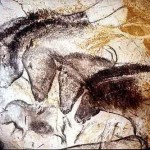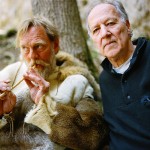Cave of Forgotten Dreams – Werner Herzog
 For a wonderful excursion away from the shattering sights and sounds of the here-and-now take a friend and an understanding of how long ago 35,000 years was to see Werner Herzog’s ”Cave of Forgotten Dreams.” It’s a transportation back into time that could just as well be a visit to an adventurous art gallery designed by Gaudi with murals by Picasso. This is, however, a natural cave-gallery with wonderful charcoal and red-mud (?) drawings of bison, fighting rhinos, leopards and especially horses done by our long ago ancestors. That would be 1,400 generations ago [the US Civil war is 6 generations ago; the Birth of Christ is 84 generations ago.]
For a wonderful excursion away from the shattering sights and sounds of the here-and-now take a friend and an understanding of how long ago 35,000 years was to see Werner Herzog’s ”Cave of Forgotten Dreams.” It’s a transportation back into time that could just as well be a visit to an adventurous art gallery designed by Gaudi with murals by Picasso. This is, however, a natural cave-gallery with wonderful charcoal and red-mud (?) drawings of bison, fighting rhinos, leopards and especially horses done by our long ago ancestors. That would be 1,400 generations ago [the US Civil war is 6 generations ago; the Birth of Christ is 84 generations ago.]
The Chauvet caves were originally discovered in 1994 and much scholarly work has been done on the bones found, the paintings, the likely origin and the place of the paintings in human history. Most of the art has been available in journals, and on line, for some time, and here. Werner Herzog, famed German film-maker, received unusual permission to go in for two short visits with a much reduced film crew to make a movie, bringing us — in 3-D no less– right into the caves themselves, and up close to many of the paintings. It is quite astounding to see them and contemplate what brought what kind of people to the cave walls, to ask how long they had been doing art of such quality — or if this was something radically new, an eccentric genius, a mutant? These were early European Cro-Magnon people appearing alongside the long present Neandertals who were making their slow exit from the scene. The paintings are more than twice as old — if all the carbon dating has been done right– as anything else that has been found. What we are seeing is, as far as we know, man’s first sketch pad.
 Herzog has always been attracted to the inexplicable and powerful. His Aguirre, Wrath of God, was a seminal portrait of a mad man at work, with the unforgettable Klaus Kinski playing the mad Spaniard. Fitzcarraldo was an epic of madness, including Herzog’s own, as he tried to film the hauling of a river steamer over Peruvian jungle mountains. Cave of Forgotten Dreams is pretty tame by comparison. The wildest wild-man is an anthropologist dressed in reindeer hide in imitation of ice-age folks, long after the cave painters. The narrative is straightforward: here’s where the mountains and river are; here’s how we got there; here’s the locked door and here are the steel pathways we have to stay on. Herzog does the commentary himself in a pleasant baritone voice. We see the film being made because, as he points out, there is no where for the crew to hide themselves.
Herzog has always been attracted to the inexplicable and powerful. His Aguirre, Wrath of God, was a seminal portrait of a mad man at work, with the unforgettable Klaus Kinski playing the mad Spaniard. Fitzcarraldo was an epic of madness, including Herzog’s own, as he tried to film the hauling of a river steamer over Peruvian jungle mountains. Cave of Forgotten Dreams is pretty tame by comparison. The wildest wild-man is an anthropologist dressed in reindeer hide in imitation of ice-age folks, long after the cave painters. The narrative is straightforward: here’s where the mountains and river are; here’s how we got there; here’s the locked door and here are the steel pathways we have to stay on. Herzog does the commentary himself in a pleasant baritone voice. We see the film being made because, as he points out, there is no where for the crew to hide themselves.
The 3-D is the surprise of the showing. It was his first use of it, and because of the setting the cameras had to be miniatures and the lights all cold. Though once in a while a hand moving too fast or too fast a pan is distracting the paintings, all on folding sweeps of stone, really come alive. We can see how the artist planned the back, or a head around a curve of stone, or used a crack in the rock as his leg-line.
I have a few quibbles, however. The narrative moves from the straightforward here’s-how-we-did it, to discreet shots of most of the paintings, to explanations by some of the scientists, and to emotive invitations by Herzog — “Everybody, quiet! Perhaps we can hear our hearts beating…perhaps the heart of the cave itself” — to a grand, wonderful finale in which the camera glides over the artwork we have already seen in detail with a lush, contemporary musical score. I would have like some of that finale to have appeared as a bit of an overture at the opening of the film — something to draw me in sooner. As it is there is quite a bit of self-referentiality in the early going.
I was as intrigued by what was not painted as what was: where were the birds? Why no humans, except for one bison-female figure? Why no predator taking down another beast? All were large, terrestrial animals. No snakes. No crocodiles. Maybe an insect or two. The animals were running, or standing; a few fighting. Herzog and his scholars stayed away from speculation about religion, hunting ritual and the like. I would have liked to know a bit about the choices for the wall, however. Is there a whole in the context of which each takes on some particular meaning? What might be true about the lives of those who did the painting? Some figures were done in such close-up detail plenty of prolonged watching time is indicated. A few suggestions about this would have been welcome. [The flute playing on the vulture fibula, and the spear throwing device were welcome additions.]
I didn’t too much like the score by Ernst Reijseger. In fact, a few times, I downright disliked it…jarring and big-city chaotic while I was trying to sink into an artist’s shadow in a cool cave thousands of years ago.
The time line of the caves, paintings, bones and stalactites and stalagmites is gradually made clear but the initial impression is of sheer wonder at the jewel-like calcium carbonate features and the art-work, compressing into one over-all shock of awe. The paintings, in fact, preceded the natural features by tens of thousands of years, probably falling an enormous landslide which sealed off the cave and preserved it, 20,000 years ago. The various bones shown were, in their own way, just as incredible, and of likely different times – from each other, and the two main features. Given how fact-ignorant most folks in the world are, I prefer making it clear at the beginning that A is A and B, B; I would have liked to see a long string of cartoon silhouettes winding across the screen, with a few dates along it, to help people grasp the length of people-time being talked about. Let the emotional synthesis and ruminations of Homo Spiritualis follow the analytic.
The odd post script of albino crocodile just left me scratching my head. I won’t go into it, but if you see it drop a comment here: what was on his mind? Nuclear as a threat? Albinism as a mutation? Time going forward hinged here, as time going backward might have hinged around the time of the paintings. Yo no sé. Ayúdame.
Oh, and he could have left out the humorous but bizarre shadow tap-dance inserted half-way through….
[Cross posted at AllInOneBoat.org]
3 Comments
RSS feed for comments on this post.
Sorry, the comment form is closed at this time.


May 8th, 2011 @ 8:53 pm
I think the albino alligators (or are they crocodiles, as you suggested?) are just dangling modifiers. Sobering ones, of course. If we can delude ourselves into thinking this is progress…
May 8th, 2011 @ 8:54 pm
P.S. I left the film assuming you would have the answer!
May 25th, 2011 @ 8:24 am
i think the albino alligators are us-transformed creatures who find ourselves in the environment we believe to be our “reality”. and just as the albino alligators would be, we are just as awestruck and blown-away without a proper ability to totally grasp the awesomeness of life and time when looking into those caves.